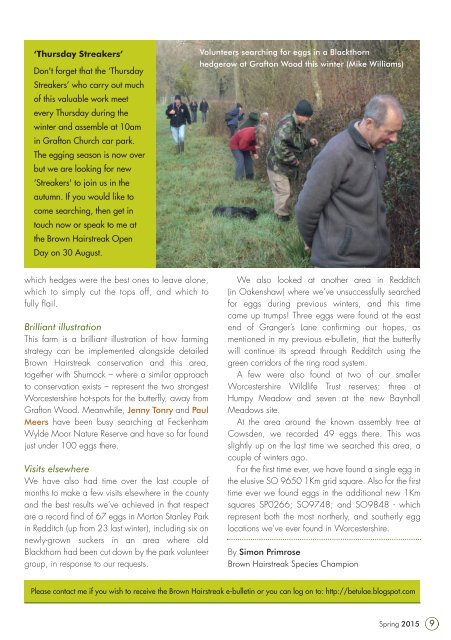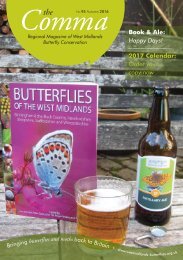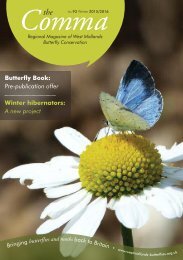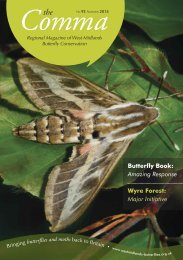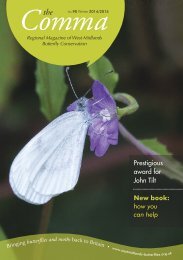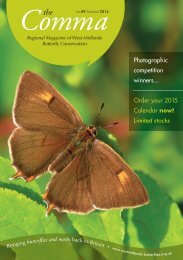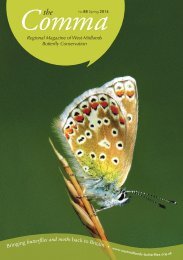Comma No91 Spring 2015
Butterfly Magazine for the West Midlands Branch of butterfly Conservation
Butterfly Magazine for the West Midlands Branch of butterfly Conservation
Create successful ePaper yourself
Turn your PDF publications into a flip-book with our unique Google optimized e-Paper software.
‘Thursday Streakers’<br />
Don't forget that the ‘Thursday<br />
Streakers’ who carry out much<br />
of this valuable work meet<br />
every Thursday during the<br />
winter and assemble at 10am<br />
in Grafton Church car park.<br />
The egging season is now over<br />
but we are looking for new<br />
‘Streakers' to join us in the<br />
autumn. If you would like to<br />
come searching, then get in<br />
touch now or speak to me at<br />
the Brown Hairstreak Open<br />
Day on 30 August.<br />
Volunteers searching for eggs in a Blackthorn<br />
hedgerow at Grafton Wood this winter (Mike Williams)<br />
which hedges were the best ones to leave alone,<br />
which to simply cut the tops off, and which to<br />
fully flail.<br />
Brilliant illustration<br />
This farm is a brilliant illustration of how farming<br />
strategy can be implemented alongside detailed<br />
Brown Hairstreak conservation and this area,<br />
together with Shurnock – where a similar approach<br />
to conservation exists – represent the two strongest<br />
Worcestershire hot-spots for the butterfly, away from<br />
Grafton Wood. Meanwhile, Jenny Tonry and Paul<br />
Meers have been busy searching at Feckenham<br />
Wylde Moor Nature Reserve and have so far found<br />
just under 100 eggs there.<br />
Visits elsewhere<br />
We have also had time over the last couple of<br />
months to make a few visits elsewhere in the county<br />
and the best results we’ve achieved in that respect<br />
are a record find of 67 eggs in Morton Stanley Park<br />
in Redditch (up from 23 last winter), including six on<br />
newly-grown suckers in an area where old<br />
Blackthorn had been cut down by the park volunteer<br />
group, in response to our requests.<br />
We also looked at another area in Redditch<br />
(in Oakenshaw) where we’ve unsuccessfully searched<br />
for eggs during previous winters, and this time<br />
came up trumps! Three eggs were found at the east<br />
end of Granger’s Lane confirming our hopes, as<br />
mentioned in my previous e-bulletin, that the butterfly<br />
will continue its spread through Redditch using the<br />
green corridors of the ring road system.<br />
A few were also found at two of our smaller<br />
Worcestershire Wildlife Trust reserves: three at<br />
Humpy Meadow and seven at the new Baynhall<br />
Meadows site.<br />
At the area around the known assembly tree at<br />
Cowsden, we recorded 49 eggs there. This was<br />
slightly up on the last time we searched this area, a<br />
couple of winters ago.<br />
For the first time ever, we have found a single egg in<br />
the elusive SO 9650 1Km grid square. Also for the first<br />
time ever we found eggs in the additional new 1Km<br />
squares SP0266; SO9748; and SO9848 - which<br />
represent both the most northerly, and southerly egg<br />
locations we’ve ever found in Worcestershire.<br />
By Simon Primrose<br />
Brown Hairstreak Species Champion<br />
Please contact me if you wish to receive the Brown Hairstreak e-bulletin or you can log on to: http://betulae.blogspot.com<br />
<strong>Spring</strong> <strong>2015</strong> 9


